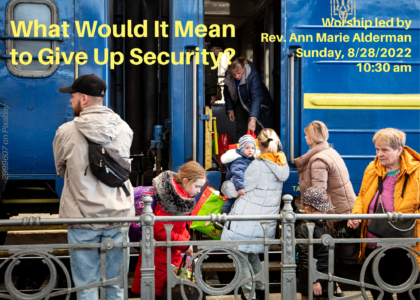Please visit our YouTube channel to watch Rev. Ann Marie’s video recording of this sermon.
Last week several of us, including me, attended a two-day “Active Shooter Awareness” training. To be honest, I was only able to attend the first day, but I learned a lot in that first day, even though I have been to these sorts of trainings before. I learned that only 4% of the time do active shooters choose houses of worship as the place where they are going to carry out their violence. Should that fact in and of itself should offer some sense of “safety?”
Last Monday, I was reminded that all of us should consider where the exits are any time we enter any building, mall, movie theater, concert hall or a crowded outdoor space. I relearned the concept of fight, hide or run. If you are going to fight, fight like your life depends on it. If you are going to hide, there is a difference between being concealed and seeking and finding cover. And then there is what most of us would choose: run. Run with your hands up and nothing in your hands.
The training offered several ways to recognize and possibly intervene to prevent those individuals who might be in the process of becoming the person whom the police call an active “murderer.” This information about what to look for—how to notice the signs of a person who would do such a thing—was important, but primarily applies to places of employment, or schools, the kinds of places where you could be aware of the indicators of a possible progression down a path that leads to an intentional mass shooting.
It was also clear that those known to us (members, “friends,” or their family members) aren’t likely to be those who would feel compelled to do such a thing here. The police and the other officials at the awareness training suggested it would be more likely be a person motivated by an ideology of hate who would enter a house of worship. Yet where that has happened, where an ideology of hate was the motivation for a shooting in a house of worship, the shooting was done by a person who was a complete stranger to the congregation. Hate drives active shooters into Jewish congregations or into a Black church; rarely a UU congregation, because we don’t even show up on the “you should hate these people” lists!
What is more likely for us is being targeted by a person who has a grievance against someone here, or someone they think is here. The shooter will have already progressed to the point where they believe murdering anyone connected with the person who aggrieves them will satisfy their sense of having been done wrong. That ex-spouse or ex-partner may not be someone we’d know well, or be in a position to recognize, or in whom we’d have observed a progression of behavior. We would be very unlikely to witness changes in their behavior over time.
That’s what happened in the Knoxville UU congregation on July 27, 2008. An unemployed Tennessee truck driver named Jim David Adkisson came in with a gun concealed in a guitar case and opened fire on members of the congregation during a church youth performance that involved the Tennessee Valley UU Church and the Maryville congregation. According to Wikipedia, “Adkisson killed two people and wounded six others before he was restrained by church members … He later said he had planned to keep shooting until the police arrived and killed him. A letter (or “manifesto”) found in his vehicle after the shooting attributed his motivation to hatred of liberals, Democrats, African Americans, and homosexuals. In the letter he also described what he believed to be the cult-like atmosphere of the church.”
Yet I heard at the time, from those familiar with that church and the UUs in that area, that they knew him as an ex-partner of another person who was only an occasional visitor at TVUUC. Adkisson was familiar to some in informal UU-inclusive circles. He felt aggrieved by something personal that morphed into a hate ideology.
Wikipedia states that Adkisson “later pled guilty to two counts of murder and received a sentence of life in prison without parole.” One of the persons who was killed that day stood in front of Adkisson when he raised his gun. No children were physically harmed, but Adkisson shot and killed another person and there were others injured. There was extensive immediate trauma to which the UU Trauma Ministry Team responded. I suspect trauma remains in the culture of that church and in the other UU congregation that was part of the event that day. For years after, TVUUC kept their front doors locked shut, even on Sunday mornings. They had to know you or the person you were with to let you in. I don’t know if they still do that. I would suspect that that and other security measures were part of their long-term trauma response. Locking doors and increasing security measures would certainly be an expected and reasonable way for them and other traumatized congregations to return to some sense of safety.
That sort of event has not happened again at a UU congregation, to my knowledge, in the nearly 15 years since. So how should we stay welcoming and keep those inside this place “safe?” It is a question that many UU congregations have asked ever since July 2008.
It seems to me to be a matter of deciding what level of risk are we willing to take.
It was clear from the shooter awareness training that the wider the perimeter of our preventative measures, the better. What that means is what we ought to be doing is keeping those intent on active shooting out of the interior of our building. You do that, per the experts, by “hardening” your perimeter with well-placed, visible, and operating exterior security cameras. You include signs that say those cameras are there and are on, you cover windows so those on the outside can’t see where we are, perhaps you make sure exterior doors are locked from the outside, or at least that entry is monitored by those trained to look for potential threats.
How would one know who might be intent on doing violence? There are ways. However, once a person at the final stage—intent on doing harm—enters our doors, the very best we can do is fight, hide, or flee, and be prepared for the resulting immediate and long-term trauma this sort of incident will cause.
There are things to learn about fight, hide and flee, such as fight like your life depends on it; there is a difference between being concealed and seeking cover; and that fleeing must include upraised empty hands.
When the police arrive, everyone is considered a suspect at first, so knowing what to do during and after is important.
A question (actually a statement) came forth during that first day of active shooter awareness training, from the leader of another house of worship. I heard this person say, “If there is a choice between a place that welcomes and a place that turns away, we are choosing to welcome. We must. That is why we exist.”
I respect that person’s perspective, but I don’t think it is an either-or choice. I think it is a matter of choosing the level of risk with which we are comfortable, while still maintaining our identity.
It is not as stark as choosing a “fear-based lockdown to all but ‘us’” kind of approach or choosing a “wide-open to anyone, anytime, come what may” approach.
If we were to choose the latter, we might feel that stationing a few trained to “know” which visitor, which stranger needs “intervention” is enough. And it might be, if they’re not yet at the end of a progression to active shooter. If we can show empathy and compassion, perhaps that will make a difference in the heart and mind of a person nursing a grievance before they become an active shooter.
Is it right or fair to expect some ushers to be that bold and sensitive?
Maybe. But we also have to accept what we can’t control. It is just naïve to expect total safety and security in this day and time, in any place. You have to consider what you are willing to risk in order to live your values, which may be multiple values, and in some ways conflicting values. How much isolation did you choose or not choose during the pandemic? Was it worth it? Or did you close yourself off from most other human beings? Was that kind of isolation worth it? Perhaps it was, for you or your family.
But should we ask that of this place? If we lock the doors on Sunday mornings, are we the welcoming and bold faith we seek to be? How long before we aren’t a UU congregation anymore, especially if we were to choose a fear-based response?
How do we choose a love-based response? Whatever we choose, there is always the risk of loss of life. We must accept that.
The Knoxville UUs are still dealing with the trauma of what happened in their space 14 years ago.
They have learned to sit and stay in that space as long as it may take, in the unexplainable grief that comes when the fabric of what we know is ripped and rendered “less than.”
Moving Forward by Sitting and Staying
“Are you sitting down?” These were not words I wanted to hear at the end of a day spent sheltering in place due to an active shooter situation in my small town—the second in ten years. But I sat down, took a deep breath, and began my journey alongside the friends and family of one of the victims, alongside a congregation and a community that had experienced a terrifying, confusing, inexplicable loss. I also began a journey through my own trauma and grief.
Six adults sitting in a circle comfort and listen to a seventh person, who appears distressed.
Traumatic experiences, by definition, make us feel overwhelmed, out of control, disconnected, and uncomprehending. Pain and grief are not pleasant feelings, either. I’m often tempted to travel as fast as I can through these uncomfortable places, but trauma defies my attempts to rush.
In the weeks and months following the shooting, I stayed in the midst of the pain by letting go of my need for control and tolerating the feelings of powerlessness. Healing wasn’t an intellectual process, but an embodied unfolding. I gave myself the space to be baffled and broken-hearted; to lament. I held space for other confused and grieving people, bearing witness to one another in love and celebrating the miraculous ways that together, we discovered a deeper resilience and a greater wisdom.
The paradox is this: the only way I’ve been able to move through trauma—my own or those of the ones I love—is to sit and stay. When I create space for what is real (however incomprehensible and heartbreaking and unbearably painful), my spirit heals. When I do this in community, I discover a deeper wisdom and a greater resilience. Somehow, the things that are too much to bear alone are bearable together.
Five years later, I got another “are you sitting down?” call. This one came when I was a continent away, supporting my mother after my stepfather’s death. “Do you need me to come home?” I asked.
“No,” said the voice on the other end of the line, a member of our lay pastoral ministry team. “You taught us how to do this. We’ll sit and stay and hold the space until you get back.”
Rev. Elizabeth Stevens
If you appreciated this reflection, please text to give or visit our Give Now page to support the UUCSH Share the Plate efforts to assist those in need.

